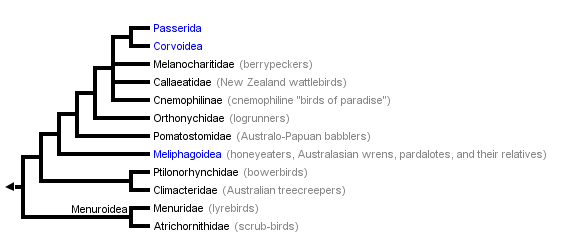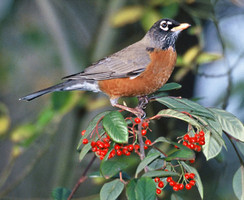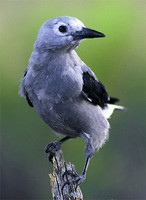Oscines
Songbirds
John Harshman


This tree diagram shows the relationships between several groups of organisms.
The root of the current tree connects the organisms featured in this tree to their containing group and the rest of the Tree of Life. The basal branching point in the tree represents the ancestor of the other groups in the tree. This ancestor diversified over time into several descendent subgroups, which are represented as internal nodes and terminal taxa to the right.

You can click on the root to travel down the Tree of Life all the way to the root of all Life, and you can click on the names of descendent subgroups to travel up the Tree of Life all the way to individual species.
For more information on ToL tree formatting, please see Interpreting the Tree or Classification. To learn more about phylogenetic trees, please visit our Phylogenetic Biology pages.
close boxDiscussion of Phylogenetic Relationships
Sibley and Ahlquist (1990) divided the oscines into two clades they called Corvida and Passerida. While Passerida has been confirmed (with some slight changes of membership), Barker et al. (2002) showed that Corvida was not a clade but a grade, as shown in the tree above. Thus Corvida, as a group, does not really exist.
Sibley and Ahlquist’s (1990) Menuroidea included Menuridae (lyrebirds), Atrichornithidae (scrub-birds), Climacteridae (Australasian treecreepers), and Ptilonorhynchidae (bowerbirds). More recent studies show that the latter two are sister taxa and are more closely related to other oscines than to Menuridae (Barker et al. 2002, 2004; Ericson et al. 2002a; Beresford et al. 2005; but see Ericson et al. 2002b). There are so far no sequence data available for Atrichornithidae, and it has been retained here within a reduced Menuroidea (Sibley and Ahlquist 1990). The unnamed group including Climacteridae and Ptilonorhynchidae is sister to all oscines other than Menuroidea (Barker et al. 2002, 2004; Ericson et al. 2002b; Beresford et al. 2005; but see Ericson et al. 2002b).
Meliphagoidea consists of Maluridae (fairy wrens), Meliphagidae (Honeyeaters), Pardalotidae (pardalotes), Acanthizidae (scrub-birds, thornbills), and Dasyornis (bristleheads) (Cracraft and Feinstein 2000; Barker et al. 2002, 2004) and is sister to the remaining oscines (Barker et al. 2002, 2004; Beresford et al. 2005). Relationships within Meliphagidae and Acanthizidae have been investigated by Driskell and Christidis (2004). Two more families, Pomatostomidae (Australian babblers) and Orthonychidae (logrunners) are successively more closely related to Corvoidea and Passerida (Barker et al. 2002, 2004).
Three more clades form a polytomy with Corvoidea and Passerida: Callaeatidae (New Zealand wattlebirds), Cnemophilinae (traditionally supposed to be birds of paradise, belonging to the corvoid Paradiseidae), and Melanocharitidae (most berrypeckers — one genus, Paramythia, is corvoid) (Cracraft and Feinstein 2000; Barker et al. 2002, 2004; Beresford et al. 2005).
References
Ames, P. L. 1971. The morphology of the syrinx in passerine birds. Bulletin of the Peabody Museum of Natural History 37:1–194.
Barker, F. K., G. F. Barrowclough, and J. G. Groth. 2002. A phylogenetic hypothesis for passerine birds; Taxonomic and biogeographic implications of an analysis of nuclear DNA sequence data. Proc. R. Soc. Lond. B 269:295-308.
Barker, F. K., A. Cibois, P. Schikler, J. Feinstein, and J. Cracraft. 2004. Phylogeny and diversification of the largest avian radiation. Proc. Natl. Acad. Sci. USA 101:11040-11045.
Beresford, P., F. K. Barker, P. G. Ryan, and T. M. Crowe. 2005. African endemics span the tree of songbirds (Passeri): Molecular systematics of several evolutionary "enigmas". Proc. R. Soc. Lond. B 272:849-858.
Chesser, R. T. and J. ten Have. 2007. On the phylogenetic position of the scrub-birds (Passeriformes : Menurae: Atrichornithidae) of Australia. Journal of Ornithology 148(4):471-476.
Cracraft, J., and J. Feinstein. 2000. What is not a bird of paradise? Molecular and morphological evidence places Macgregoria in the Meliphagidae and the Cnemophilinae near the base of the corvoid tree. Proc. R. Soc. Lond. B 267:233-241.
Ericson, P. G. P., L. Christidis, M. Irestedt, and J. A. Norman. 2002a. Systematic affinities of the lyrebirds (Passeriformes: Menura), with a novel classification of the major groups of passerine birds. Mol. Phylogen. Evol. 25:53-62.
Ericson, P. G. P., L. Christidis, A. Cooper, M. Irestedt, J. Jackson, U. S. Johansson, and J. A. Norman. 2002b. A Gondwanan origin of passerine birds supported by DNA sequences of the endemic New Zealand wrens. Proc. R. Soc. Lond. B 269:235-241.
Ericson, P. G. P., U. S. Johansson, and T. J. Parsons. 2000. Major divisions in oscines revealed by insertions in the nuclear gene c-myc: a novel gene in avian phylogenetics. Auk 117:1069-1078.
Ericson PGP, Christidis L, Irestedt M, Norman JA. 2002. Systematic affinities of the lyrebirds (Passeriformes : Menura), with a novel classification of the major groups of passerine birds. Mol. Phylogenet. Evol. 25:53-62.
Harshman, J. 2007. Classification and phylogeny of birds. Pages 1-35 in Reproductive biology and phylogeny of birds (B. G. M. Jamieson, ed.). Science Publishers, Inc., Enfield, NH.
Irestedt, M. and J. I. Ohlson. 2008. The division of the major songbird radiation into Passerida and ‘core Corvoidea’ (Aves: Passeriformes) — the species tree vs. gene trees. Zoologica Scripta, doi:10.1111/j.1463-6409.2007.00321.x
Jønsson, K.A. and J. Fjeldså. 2006. A phylogenetic supertree of oscine passerine birds (Aves: Passeri). Zoologica Scripta 35:149-186.
Jønsson, K.A., J. Fjeldså, P.G.P. Ericson, and M. Irestedt. 2007. Systematic placement of an enigmatic Southeast Asian taxon Eupetes macrocerus and implications for the biogeography of a main songbird radiation, the Passerida. Biology Letters 3(3):323-326.
Sibley, C. G., and J. A. Ahlquist. 1990. Phylogeny and classification of birds, Yale U. Press, New Haven.
Title Illustrations

| Scientific Name | Cardinalis cardinalis |
|---|---|
| Location | Arizona |
| Comments | A cardinal bird |
| Specimen Condition | Live Specimen |
| Copyright | © 1995 D. Brent Burt |
| Scientific Name | Turdus migratorius |
|---|---|
| Comments | American robin |
| Creator | Lee Karney |
| Specimen Condition | Live Specimen |
| Source Collection | U.S. Fish and Wildlife Service Online Digital Media Library |
| Scientific Name | Nucifraga columbiana |
|---|---|
| Location | Oregon |
| Comments | Clark's nutcracker |
| Creator | Dave Menke |
| Specimen Condition | Live Specimen |
| Source Collection | U.S. Fish and Wildlife Service Online Digital Media Library |
About This Page
Correspondence regarding this page should be directed to John Harshman at
jharshman@pacbell.net
Page copyright © 2013 John Harshman
 Page: Tree of Life
Oscines. Songbirds.
Authored by
John Harshman.
The TEXT of this page is licensed under the
Creative Commons Attribution-NonCommercial License - Version 3.0. Note that images and other media
featured on this page are each governed by their own license, and they may or may not be available
for reuse. Click on an image or a media link to access the media data window, which provides the
relevant licensing information. For the general terms and conditions of ToL material reuse and
redistribution, please see the Tree of Life Copyright
Policies.
Page: Tree of Life
Oscines. Songbirds.
Authored by
John Harshman.
The TEXT of this page is licensed under the
Creative Commons Attribution-NonCommercial License - Version 3.0. Note that images and other media
featured on this page are each governed by their own license, and they may or may not be available
for reuse. Click on an image or a media link to access the media data window, which provides the
relevant licensing information. For the general terms and conditions of ToL material reuse and
redistribution, please see the Tree of Life Copyright
Policies.
- First online 31 July 2006
- Content changed 31 July 2006
Citing this page:
Harshman, John. 2006. Oscines. Songbirds. Version 31 July 2006 (under construction). http://tolweb.org/Oscines/29222/2006.07.31 in The Tree of Life Web Project, http://tolweb.org/












 Go to quick links
Go to quick search
Go to navigation for this section of the ToL site
Go to detailed links for the ToL site
Go to quick links
Go to quick search
Go to navigation for this section of the ToL site
Go to detailed links for the ToL site